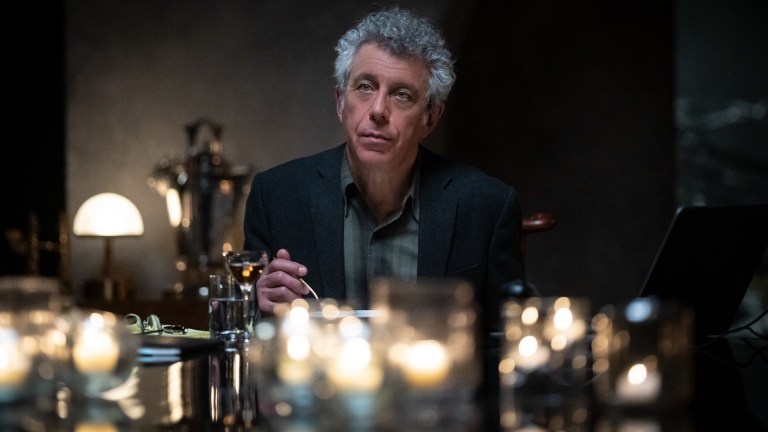Interview with the Vampire Episode 1 Review: In Throes of Increasing Wonder
AMC’s new dead not only walk but talk eloquently, as Anne Rice’s Interview with the Vampire begins “In Throes of Increasing Wonder.”

This Interview with the Vampire review contains spoilers.
Interview with the Vampire Episode 1
Welcome to the world of Anne Rice’s vampires. The landscape has changed, but the emotional intent remains. Entitled “In Throes of Increasing Wonder,” the premiere episode aims to evoke the feeling. Anne Rice’s Interview with the Vampire makes its introduction via Eric Bogosian’s Daniel Molloy. He was the young, unnamed “boy reporter” who interviewed Louis de Pointe du Lac (Jacob Anderson) in the 1976 novel Interview with the Vampire. He sets the tone for how the narrative has changed in the almost-half-century since recording the tapes in 1973. Molloy is teaching online journalism classes now, and can be canceled at any moment.
And there you have it. AMC’s adaptation of the Vampire Chronicles is exactly that, adapted and threatened with all manner of cancellation. Mostly because of the changes to the book series. The aging journalist cannot be the Daniel who received the Dark Trick from the vampire Armand between the novels The Vampire Lestat and The Queen of the Damned. Fans will hold series creator and episode writer, Rolin Jones, accountable. It is to his credit the series lays it out at the outset.
Interview with the Vampire is set in contemporary time, specifically opening during COVID-19 the pandemic, and the origin story has also shifted. Are these hanging offenses, as Sylvio Dante would ask Tony Soprano on The Sopranos? Not if the series works on its own. And it does. Interview with the Vampire is recreating the mythology in a horror series which works as a horror series. Even though the first episode is a setup, presenting Louis as he was before he became as he is, it moves fast, has thrills, spills blood, and maintains a vague but steady air of foreboding.
Louis’ introduction is far from menacing, he is concerned about Molloy’s Parkinson’s Disease. This development further distances the characters from the book, but allows the altered background to be filled in, and doubles as a veiled threat of privileged information in the hands of a privileged few. Molloy hasn’t been doing well. Between his failed marriages, addictions, and reputation, he is a ghost of his former self. He believes the original 1973 tapes captured a “fever dream told to an idiot.” His newly accepted vampire interview sessions often get deliciously heated to make up for it. Louis has thrived, as is evidenced by his palatial apartment in Dubai. He can even stay out of the sun while enjoying daylight. Louis, as a young man, is also not what he was. His former self is the ghost.
Pre-vampire Louis is an engaging and likable character, if not the book’s original. Anderson appears to enjoy playing “a rougher thing,” even as the modern Louis coyly appears to try and play it down while remembering the sordid details. “You couldn’t look weak on Liberty Street,” he explains. The sugar plantations of the novel have faded into a failed chapter of family history in the series, and the new family business is bordellos. The slave-owner of the book is now a pimp. In the segregated deep south, Louis is a fairly successful erotic entrepreneur, whose establishments of “desire” make up a vast enterprise of local businesses. He’s also gotten further into local politics than other African Americans in the Parish, even if his businesses are restricted geographically.
Storyville is “20 blocks of drinking, gambling, and whoring,” Louis says. The historic red-light district is rendered beautifully. The sets and design are uniformly magnificent. New Orleans is portrayed as a thriving, jovial, and dangerous country city, with hidden dangers and pleasures available in equal measure, and a card game in every back room. It is decadence on a reasonable budget, but not for the poor, and corruption holds it all together.
Louis also maintains a very friendly relationship with his church’s priest. This establishes Louis as a Roman Catholic man with emotional roots in the community just as much as his business interests insinuate the political community into his mortal bonds. Until death makes them part, cutting in unexpectedly from all sides. One of the highlights of the episode is a wedding day dance duet between Louis and his brother Paul (Steven Norfleet), complete with the patter of soft-shoe hoofers of the era. Not only is it a change of pace, with character-deepening abandoned enjoyment, but it is also an exciting sequence, made more memorable because of the music, which sets the time and neighborhood better than any narration or setting.
The de Pointe du Lac family has more of a presence in the series than in the book. This isn’t saying much, as it feels like the literary Louis spends more time with his hounds than his siblings. We have to care for his family quickly, because we know they won’t be around too long, and AMC doesn’t want them to be forgotten as the story moves far beyond Louis’ mortal shuffle. Get used to them, the series wants to break your heart. Paul’s visions and unseen birds frighteningly take on a more human quality on screen than the page. He tugs the tender strings with righteous rage, but he is a godsend for something slightly less deified.
Lestat de Lioncourt (Sam Reid) is drawn to Louis because he sees a man pull a blade from a walking stick and hold it to the breast of his own brother. This is love at first sight for a creature looking for his evening’s first bite, and Reid luxuriates in the appraisal. Lestat is a shadow-like creature, trailing behind the figures, unidentifiable, but unmistakable. His first swoop into full frame establishes him as a foreign object, alien, otherworldly, and a center which holds the attention after the camera moves on.
Reid establishes Lestat as an understated sociopath in his introduction with Louis. His stare is beyond vampiric as he pins the tough cathouse owner to his chair with it. The audience knows this is vampire telepathy before it is made obvious, but the psychopathic intensity Reid puts into Lestat’s bullying gaze is formidable. His highpoint really comes in a “ocean between Christ and myself” tirade. It is the only time Lestat loses his cool, and shows there is a deep well of something other than anger or, as he puts it boredom, at an all-too-blatantly-innocent question.
Religious ambiguity regularly beats deep in the blessed heart of the Vampire Chronicles. Using the blasphemy for its visual beauty, Anne Rice’s Interview with the Vampire translates the underlying subtext with astounding immediacy. Louis’ mother, played by Rae Dawn Chong, doles out the Catholic guilt with a devastating clarity. The vampires reject it without apology.
The first seduction ends operatically, and the romance is an aria of arousal. Louis speaks of the intimacy Lestat awakens with a tiny bite. Then he comes down to the reality of his circumstances. Sadly, you can “be a lot of things in New Orleans, but an openly negro man was not one of them.” The second seduction is life-changing, a cliffhanger the audience always knew was coming. It is the leap we have been waiting for since the theme music chord turned sour in ever-increasing dissonance.
The first clues to the vampire subplot come through in the same way as classic horror films. A seemingly innocent street scene is bloodied in a whirlwind of improbabilities, followed by a group of men discussing a strange rash of deaths in the Quarter. Reports circulate of a group of unfortunates with small wounds who had been drained of blood. The same was said of Bela Lugosi’s Dracula before he unveiled his cape. Classic suspense is eternal, and some homages are shortcuts to timeless horror which still has the power to scare.
“In Throes of Increasing Wonder” is a fully satisfying introductory course, serving up preface as first chapter. Anne Rice’s Interview with the Vampire addresses issues with Rice’s novel head on, and self-referentially, which is disarming. As Louis tells his resistant profiler, let the tale seduce you. The first episode is a hunt, and at the end, viewers will be trapped. It opens a whole new vein.
Interview with the Vampire airs Sunday nights at 10 p.m. ET on AMC and AMC+.

